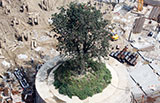Full Text: Historical Witness to Ethnic Equality, Unity and Development in Xinjiang
(Xinhua) Updated: 2015-09-24 13:13V. Promoting cultural prosperity
Since the autonomous region was established in 1955, Xinjiang has attached great importance to culture, promoting the preservation, bequeathal and onward transmission of fine cultural traditions, and vigorously developing modern culture, in order to meet the ever growing cultural needs of the people of all ethnic groups and safeguard their equal cultural rights and interests.
Public cultural services have improved remarkably. In 1955, Xinjiang had only one public library and 36 cultural centers. In 1978, Xinjiang built its first museum. In 2007, with state support, Xinjiang launched two nonprofit cultural projects - the East Wind Project (to give books and publications free of charge) and the Rural Library Project (to provide farmers with books, periodicals, newspapers and audio and video products). In 2008 and 2012, Xinjiang started the Radio and TV Programs for Each Village Project and the Radio and TV Programs for Each Rural Household Project, both benefiting all local rural population. By 2014, every administrative village in Xinjiang had its own rural library.
Since 2010, the state and the autonomous region have provided a total of RMB1.5 billion to improve cultural infrastructure, launching the County-level Library and Cultural Center Renovation Project, the National Cultural Information Resources Sharing Project (constructing information centers to share Xinjiang' s resources with other areas of the country), and the Town and Township Comprehensive Cultural Center Project, as well as the aforementioned Radio and TV Programs for Each Village Project and Radio and TV Programs for Each Rural Household Project. By 2014, Xinjiang had built 117 cultural centers, 107 public libraries, 82 museums (memorial halls) and 1,147 cultural activity venues, made radio and TV access to 3.46 million rural households, and completed the basic public cultural service system of four levels (the autonomous region, prefecture, county (city) and town (township)).
Cultural heritage has been effectively protected. Xinjiang has 113 cultural relic sites under state protection, and 550 under autonomous regional protection. The region boasts 128,894 individual items or sets of cultural relics. "Silk Roads: The Routes Network of Chang' an-Tianshan Corridor" has been designated as a World Heritage Site. Gaochang Ancient City Ruins, Jiaohe Ancient City Ruins, Beiting Ancient City Site, Kizilgaha Beacon Tower, Kizil Grottoes and Subashi Buddhist Temple Ruins are the first group to be listed in the World Heritage Sites in Xinjiang. The autonomous region has collected and registered 11,194 copies of ancient ethnic minority books, and edited and published 140 of them. Sixty-six ancient ethnic minority titles have been included in the Catalogue of National Rare Ancient Books. Kutadgu Bilig and A Comprehensive Turkic Dictionary, masterpieces of the Karahan Kingdom, which were almost lost to posterity, have been translated into and published in both Uygur and Han Chinese. In 2009, the autonomous region launched the Uygur Historic and Cultural Preservation Project - Renovation of Dilapidated Buildings in the Old Kashi City Proper. By 2014, this project had received grants amounting to RMB3 billion, and old and dilapidated buildings for 31,000 households had been renovated.
Currently, Xinjiang has three projects on the UNESCO Intangible Cultural Heritage List and the List of Intangible Cultural Heritage in Need of Urgent Safeguarding - The Art of Xinjiang Uygur Muqam, the Epic of Manas, and the Meshrep, in addition to 127 items of intangible cultural heritage of state class and 293 items of the autonomous regional class, as well as 64 representative trustees of intangible cultural heritages at state level and 459 at autonomous regional level. In 2010, Regulations of Xinjiang Uygur Autonomous Region on the Preservation of the Art of Uygur Muqam was promulgated, which was China' s first separate regulations at provincial level designed to protect intangible cultural heritage. The autonomous region has collected more than 700 long folk poems of the Uygur, Kazak, Mongol, Kirgiz and other ethnic groups. Vigorous efforts have been made to preserve traditional ethnic cultural treasures, such as the Mongolian epic Janger, the Kazak' s ballad singing Aytes, the Hui folk song Hua' er, the Tajik' s Eagle Dance and the Xibe' s West Moving Festival.
Literature and arts are prospering. Since the founding of the autonomous region, Xinjiang' s folk and classical literature has been collected, collated, translated, published and studied. Writers, poets, translators, playwrights, performing artists, literary critics of all ethnic minority origins have rapidly matured, forming a multiethnic literary writing, performing and research contingent. Works of excellence have been staged, including Hello, Apandi (acrobatic show), Grand Bazaar (drama), Gherip-Senem (opera), Visitors on the Icy Mountain (musical), Love over the Tianshan Mountains (musical), and The Spring of Muqam (song and dance drama). A group of literary and art works have won the Best Works Award, the Lu Xun Literary Prize, the Gold Award of the National Ethnic Minority Theatrical Festival, Splendor Award and Lotus Award for Stage Arts of Excellence (the former for theatrical artworks and the latter for dance), the China Acrobatic Golden Chrysanthemum Award, the Steed Award (for ethnic minority writers), the Tianshan Literary Prize, and other national and autonomous regional prizes.
Press and publishing are making steady progress. In 2014, Xinjiang published 111 newspapers, including 51 in ethnic minority languages, and 199 periodicals, including 116 in ethnic minority languages and three in foreign languages. Xinjiang Daily, published in four languages - Uygur, Han Chinese, Kazak and Mongolian - is the official provincial-level newspaper published in the largest number of languages in China. Xinjiang Economic Daily has been published in Urumqi. Urumqi Evening News (Uygur edition) is China' s first evening post published in ethnic minority languages. Kizilsu News (Kirgiz edition) is China' s only newspaper published in the Kirgiz language. Qapqal News is the world' s only newspaper published in the Xibe language. Xinjiang now has 13 publishing houses publishing books, audio and video products, and e-publications in six languages - Uygur, Han Chinese, Kazak, Mongolian, Kirgiz and Xibe. Since 2010, the autonomous region has launched several major publishing projects, including Xinjiang' s Library, Xinjiang Ethnic Literary Creation and Chinese-Ethnic Minority Language Translation Project, and Encyclopedia Sinica (Uygur and Kazak editions). A group of excellent publications have won the Best Works Award, the China Government Award for Publishing, and other national awards.
The radio, film and television industries are developing rapidly. By 2014, Xinjiang had five radio stations, eight TV stations, 92 radio and TV stations, and 66 medium and short-wave radio transmitter and relay stations. Some 96.5 percent of the local population had access to radio, and 96.9 percent to TV. Xinjiang People' s Broadcasting Station now provides 12 radio channels in five languages - Uygur, Han Chinese, Kazak, Mongolian and Kirgiz, and Xinjiang TV provides 12 TV channels in four languages - Uygur, Han Chinese, Kazak and Kirgiz. Radio programs from Xinjiang People' s Broadcasting Station are available to the world through Xinjiang News Online (http://www.xjbs.com.cn) and CRI Online (http://gb.cri.cn). Xinjiang' s radio and TV programs have been broadcast in Kirghizstan, Uzbekistan, Kazakhstan, Mongolia and Turkey. Xinjiang TV is the provincial-level TV station boasting the largest number of channels and broadcasts in the largest number of languages in China; its program signal covers the whole of the region, the capital cities of all provinces and autonomous regions, plus the Hong Kong and Macau SARs. In the last five years, Xinjiang has dubbed an annual average 5,500 episodes of ethnic minority films and TV plays, and a number of fine films, radio and TV programs have won the Best Works Award, the China News Award and the China Huabiao Film Awards.
New media is developing rapidly. Currently, Xinjiang has nearly 17,000 registered websites and 11.4 million netizens, and about 50 percent of the local population has access to the Internet. In 2014, the autonomous region opened a WeChat public account called "The Last Kilometer," which covers all parts of China and dozens of other countries and regions. This has become an important public platform to spread the voice of Xinjiang and discuss issues in relation to Xinjiang. The autonomous region, the various subordinating prefectures and counties have jointly developed a "zero-distance" Internet communication platform, which constitutes a new system of international communications.
Cultural exchanges with other countries are becoming increasingly lively. The autonomous region has sent delegations to more than 60 countries and regions, including the US,Germany,Japan, Kazakhstan, Turkey and Libya, to participate in academic exchanges, hold exhibitions of cultural relics and stage theatrical performances. Xinjiang has registered and founded publishing institutions in Turkey, Kazakhstan and the US. China Xinjiang International Ethnic Dance Festival, Chinese and Foreign Culture Week of China-Eurasia Expo, and China Xinjiang International Arts Biennale have become brand-name cultural exchange projects of considerable international influence.
Sports have been promoted. Xinjiang had 425 sports venues of various types in 1955. By 2014, it had more than 26,000. The autonomous region encourages people to participate in the nationwide fitness campaign. It has held 13 Sports Meets of Xinjiang Uygur Autonomous Region, eight National Traditional Ethnic Minority Sports Meets, various sports meets for senior citizens, and Paralympic sporting events. Rural sports are thriving. Xinjiang has established 7,726 Farmers' and Herders' Sports and Fitness Projects at village level. These sports events and fitness activities have been much appreciated by the local farmers and herders. By 2014, the autonomous region had identified and revived 629 traditional ethnic minority sports. The Uygur traditional tightrope-walking activity known as Darwaz is of great repute around the world.
Cultural and sports industries have maintained a sound momentum of development. By 2014, Xinjiang had established six state-class cultural industry demonstration bases, 20 cultural industry parks (zones) at the autonomous regional and prefectural levels, and 76 cultural industry demonstration bases at the autonomous regional level. In recent years, the region has been proactively experimenting with the professionalization and commercialization of sports; a group of professional sports clubs have been introduced and established, including Xinjiang Tianshan Snow Leopard Football Club and Tianshan Women' s Basketball Club. Sports events and the market for sports performances are flourishing; Taklimakan Rally and CBA (Chinese Basketball Association) matches in Xinjiang have been commercial successes. Xinjiang has fostered a sports and fitness market supported by grassroots clubs, and promoted distinctive mass sports events. Continuous development has been seen in the sports leisure market, represented by the China International Camping Congress and the International Desert Hiking Contest, and featuring in particular winter sports and air sports.
- China respects religious freedom, but fights extremism: white paper
- Shanghai slaps three-year ban on entertainers caught doing drugs
- China issues white paper on Xinjiang ethnic equality, unity
- Another corruption suspect repatriated from US to China
- Cross-border triad operation snares 19,000 crime suspects
- Leaders target ongoing bureaucratic inaction
- Beijing to add bicycles, crack down on illegal parking
- Wastewater cleaning finished at Tianjin blast site
- 877 investigated for corruption in financial sector
- Xinjiang gets a helping hand to improve locals' livelihoods







